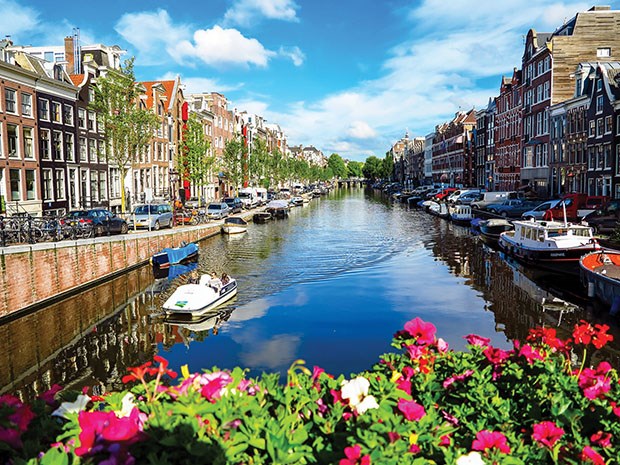“The old buildings alongside the canals are built leaning forward with hooks near the roofline,” says an audio-voice. “Years ago when the city used to flood, goods had to be hoisted by pulley to the upper window; the tilt ensured the cable and product would not hit the facade.”
My husband Rick and I are cruising along one of the many canals radiating out from central Amsterdam like silky blue ribbons joined with solid stitches of bridges to the tapestry of land. Captain Frank is adept at maneuvering our Blue Boat past breathtaking scenery while we listen to more tidbits about this historic city.
Then, it’s off the boat and onward to Central Station where we catch a bus to Zaanse Schans for, as Rick reasons, “You can’t visit Holland without seeing the old windmills!”
Arriving at a village setting of stilt-houses, small shops and factories, we are time-warped back to the 17th and 18th centuries.
The scent of chocolate lies heavy in the air from the area’s many chocolate factories — and right inside Zaanse Museum is one that has been operating for 100 years. Willy Wonka has nothing over the Verkade Chocolate and Biscuit Factory.
Wheels and rollers turn cocoa beans into thick creamy bars and rounds of dough into crispy delights. We do justice to the sample bar and purchase a stash for later.
Then it’s out to the sizable grounds of the complex — and there they are. The slow rotation of large wooden arms power machines in the factories below — a sawmill, paint mill, and spice mill. Investigating the latter, we see huge stone grinders pulverising spices.
Another small factory carves out wooden shoes or “klompen” (now mostly for sale to tourists). The museum section displays styles through the ages, ones for work and ones for Sunday best. My opinion of them being clumsy dissolves on seeing the staff move around in them with ease.
Seeing a mini-factory churning out cheese next to a bakeshop translates into purchases for our scrumptious picnic lunch.
Back in Amsterdam, we enter Anne Frank Huis (House) where this young Jewish girl wrote her diaries. A secret bookshelf opens to the annex where Anne, her mother, father, sister, plus four others hid from the Nazis during the Second World War. Being in these hidden rooms is a haunting and moving experience.
Art and Amsterdam are synonymous. The Van Gogh Museum boasts the world’s largest collection of this postimpressionist’s soulful work. Another day, it is the Rijksmuseum with over 8,000 works of art. On the second level, we find paintings by Johannes Vermeer that uncannily resemble photography, except this Dutch artist lived 350 years ago, which is 150 years before cameras were invented.
We next seek out Rembrandt’s The Night Watch and absorb his style of enhancing the most important persons and items in the painting with light. For more of this renowned artist we visit the Rembrandt House Museum (Museum het Rembrandthuis), where he spent 20 years before declaring bankruptcy.
Leaving Rembrandt House I am raring to push onto another site but know I’ve taxed Rick’s regular feeding time when he stops abruptly and growls, “Irene, I don’t care where we go next, as long as it serves food.”
At the small cafe called Rembrandt Corner, we dive into soup so thick our spoons could stand upright. The sightseeing resumes.
The magical quality of Amsterdam’s canals and lovely countryside, coupled with its rich culture and fascinating history, won our hearts. We look forward to someday seeing more of what has been called “a very big small country.”
Travel Writers’ Tales is an independent travel article syndicate that offers professionally written travel articles.



